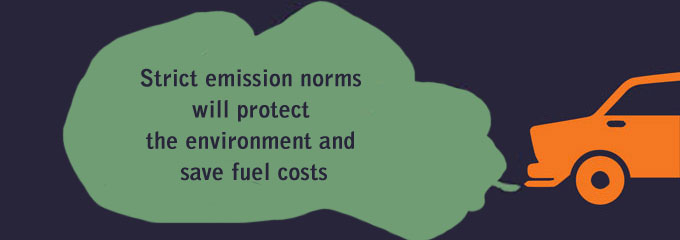
Rising transportation activity is both a cause and an effect of India's rapid economic growth. The growth in personal as well as freight vehicles, and the corresponding surge in fuel use, is expected to continue through the next several decades.
This rapid growth has its own down sides. India’s reliance on imported fossil fuels will rise sharply. This in turn will not only adversely affect the carbon emissions but will also make India as one of the major environment polluters in the world.
By implementing the Bharat VI emission standards as soon as possible, the country would be able to take full advantage of the fuel savings offered by the diesel technology (low-sulfur fuels) without raising alarms about the increasing burden of air pollution. The BS-IV auto fuels have already been introduced in some parts of the country and will be introduced in the entire country by 1 April 2017. Currently, BS IV-compliant fuel is supplied in 15 major cities while the rest of the country still uses BS III-compliant fuel. It is decided that the country will leap frog directly from BS-IV to BS-VI fuel standards which will be implemented in the country w.e.f. 1 April 2020.
The following table represents Fuel Property Changes:
|
Emission Norms
|
Sulphur in Gasoline
(Values in ppm)
|
Sulphur in Diesel
(Values in ppm)
|
|
BSI |
500 |
2000 |
|
|
500 |
500 |
|
BSIII |
150 |
350 |
|
BIV |
50 |
50 |
|
BSV |
10 |
10 |
|
BSVI |
10 |
10 |
Refinery Upgradation
Indian Oil Corporation (IOC) is investing Rs 7,000 crore in upgrading fuel quality from Bharat Stage-III, equivalent to Euro-III emission norm, to BS-IV by 2017. Another Rs 13,000 - 14,000 crore will be invested in six units to upgrade fuel quality straight to BS-VI or Euro-VI. IOC has commenced to award contracts to upgrade its flagship 13.7 mln tpa refinery in Vadodara, Gujarat, to comply with BS IV fuel standards. It is also having preliminary discussions to upgrade its Mathura (8 mln tpa) and Barauni (6 mln tpa) refineries.
IOC aims to invest Rs 4,000 crore to upgrade its Paradip refinery in Odisha after the central government decided to bring forward by four years the introduction of road vehicle fuels which are compliant with Euro VI emission standards to April 2020. It needs to add facilities like Isomerisation, Diesel Hydrotreater and a Hydrogen units to produce Euro VI compliant fuels at the Paradip refinery.
Oil minister, Dharmendra Pradhan, recently laid the foundation stone of the Octomax unit at Mathura refinery in Uttar Pradesh that will help in the production of high-octane gasoline. Octomax, a novel technology developed in-house by the Research and Development Centre of Indian Oil, involves conversion of cracked C4 streams to high-octane gasoline blending stock for production of Euro-IV/V equivalent gasoline.
Recent developments in the Automobile industry
Two-wheeler market leader, Hero MotoCorp, has inaugurated a new research and development centre in Jaipur, Rajasthan, on 10 March 2016. The Centre has been built at a cost of Rs 850 crore over the past two years.
Mahindra & Mahindra (M&M) plans to invest around Rs 1,000 crore in developing petrol engines over the next two to three years. The company is working on developing new petrol engines (1.5 litre and 1.6 litre) in-house and a 2.2-litre petrol engine in collaboration with Korean subsidiary SsangYong Motor Company (SMC). There are four engines that will be available in petrol, 1.2 litre, 1.5 litre, 1.6 litre and 2.2 litre, and in some time M&M will strap them across its entire product portfolio.
In Feb 2016, a MoU was signed between M&M and the Maharashtra state government to execute its Rs 8,000 crore investment at its automotive plants in the state over the next seven years. The investment will be utilised towards infrastructure development, product development and capacity expansion of vehicles.
Also in Feb 2016, Japanese two-wheeler giant, Honda Motorcycle and Scooter India (HMSI), started its fourth plant in India at Vithalapur in Gujarat. With the Gujarat plant commencing full production, HMSI's net installed capacity in India will be scaled up to 5.8 million units per annum from 4.6 million units at present.
|